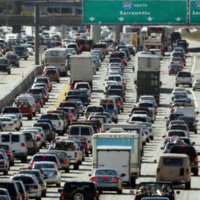Vehicle Air Pollution Found Farther from Freeways than Expected
 Interstate 405 in Los Angeles (photo: Reed Saxon, Associated Press)
Interstate 405 in Los Angeles (photo: Reed Saxon, Associated Press)
If you think that you are safe from freeway air pollution because you live more than 1,000 feet from the source, think again.
A new study published in the journal Atmospheric Environment, based on information gathered by the California Air Resources Board (CARB) and UCLA, extends the danger zone to more than a mile away.
Most pollution studies of freeways in the past were conducted during the day or evening, when weather conditions are more conducive to containing particulate matter from drifting downwind. But a 2009 study of the 10 Freeway through the heart of Los Angeles, conducted before sunrise, found air pollution much farther from the road, according to the Los Angeles Times.
So CARB cranked up its mobile monitoring equipment, Toyota RAV 4 Electric Vehicles, and hit the road with UCLA researchers in 2011 to take samples in neighborhoods surrounding four different freeways in Los Angeles County before dawn.
They found a lot more pollution. The culprits are surface inversions caused by evening cool air that trap concentrated pollutants near the ground, allowing the gunk to blow farther away.
The researchers speculated that the dispersed pollution means that one in four people living in the Los Angeles area might be exposed to hydrocarbons, nitric oxide and other particulate matter that can lead to asthma, heart disease and other ailments.
–Ken Broder
To Learn More:
A Quarter of Angelenos Breathe Noxious Freeway Pollutants Every Morning (by Alison Hewitt, UCLA Newsroom)
Freeway Air Pollution Travels Farther in Early Morning (by Bettina Boxall, Los Angeles Times)
Mobile Monitoring Research Project (California Air Resources Board)
Ultrafine Particle Size Distributions near Freeways: Effects of Differing Wind Directions on Exposure (Atmospheric Environment)
- Top Stories
- Controversies
- Where is the Money Going?
- California and the Nation
- Appointments and Resignations
- Unusual News
- Latest News
- California Forbids U.S. Immigration Agents from Pretending to be Police
- California Lawmakers Urged to Strip “Self-Dealing” Tax Board of Its Duties
- Big Oil’s Grip on California
- Santa Cruz Police See Homeland Security Betrayal in Use of Gang Roundup as Cover for Immigration Raid
- Oil Companies Face Deadline to Stop Polluting California Groundwater





